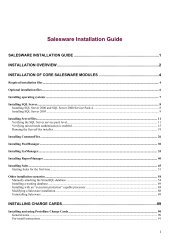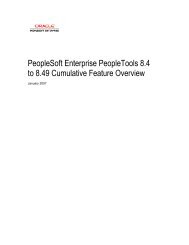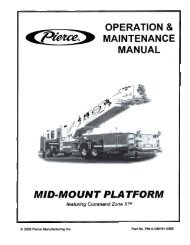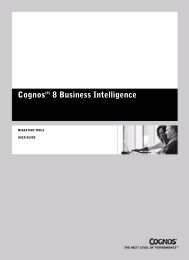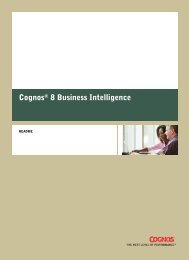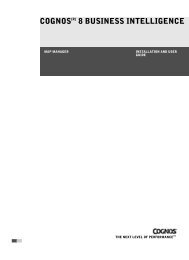COGNOS Business Intelligence Series 7
pes.pdf
pes.pdf
Create successful ePaper yourself
Turn your PDF publications into a flip-book with our unique Google optimized e-Paper software.
Chapter 4: Deploy Cubes and Reports<br />
Some cube properties are common to reports. These common properties are transferred to the<br />
folder named for the cube as report settings. The folder’s report settings are then applied to the<br />
reports in that folder.<br />
From the example above, the sales cubes folder in the imported_reports folder will have the same<br />
properties as the original sales cube folder.<br />
The outdoors folder will have the folder settings from its parent folder.<br />
The report (in this case, named 44_433) will have the following properties from the outdoors<br />
cube:<br />
• Sharing<br />
• Auditing Level<br />
• Publishing<br />
• Screen Resolution<br />
• Drill Through enabling<br />
The migration of these properties is done only once. After the creation of the folders, you will<br />
have to maintain the settings manually. This means that any modification of the cube or folder’s<br />
properties should also be applied to the equivalent cube or folder in the imported_reports folder.<br />
Publish to Cognos ReportNet or Cognos 8<br />
You can publish cubes and reports to Cognos Connection, the portal to Cognos ReportNet or<br />
Cognos 8, to provide Cognos ReportNet and Cognos 8 users with single click access to data in<br />
PowerPlay Web. If you publish a folder, all the cubes and reports in the folder are published to a<br />
Cognos Connection folder. In order to publish cubes and reports from PowerPlay Enterprise -<br />
Server Administration to Cognos Connection, Access Manager security (p. 24) must be set.<br />
The Cognos Connection folder to be published to is a folder object property (p. 90) and must be<br />
set before attempting to publish. The PowerPlay Enterprise Server must be secured against the<br />
same namespace as the Cognos ReportNet or Cognos 8 server before attempting to publish. Also,<br />
the Default Portal property (p. 84) must be set to Cognos ReportNet or Cognos 8.<br />
If these are not set, then the Publish to Portal option is unavailable.<br />
You cannot publish PowerPlay Portable Report files (.ppx) that have local cube references.<br />
PowerPlay Portable Report files are published from PowerPlay client applications and can be<br />
added to the PowerPlay Enterprise Server (p. 41). You can update all .ppx files that have local<br />
cube references to have remote cube references instead. For more information, see "Update<br />
Reports to Reference Remote Cubes" (p. 42).<br />
Steps<br />
1. In PowerPlay Enterprise - Server Administration, select a cube, report, or folder.<br />
Note: Do not publish content located in the imported_reports folder.<br />
2. From the Tools menu, click Publish to Portal.<br />
The cube or report is published to the folder specified in the Cognos ReportNet/Cognos 8<br />
Folder for Cubes or Cognos ReportNet/Cognos 8 Folder for Reports properties. This setting<br />
is made at the folder level.<br />
Notes<br />
• Cubes published from PowerPlay Enterprise - Server Administration become linked items in<br />
Cognos Connection. References to the published reports are added to the Cognos ReportNet<br />
or Cognos 8 server. The references can be deleted by a Cognos ReportNet or Cognos 8<br />
administrator, but the objects remain in PowerPlay Enterprise - Server Administration.<br />
• If you publish a folder to Cognos Connection, only the cubes and reports contained in that<br />
folder appear in Cognos Connection. The folder will not appear in Cognos Connection. A<br />
folder hierarchy that you have created in PowerPlay Enterprise - Server Administration is not<br />
maintained when you publish the folder to Cognos Connection.<br />
• In a multiple server environment, if a report or a cube is to be published, you must ensure that<br />
the report or cube resides in a folder mapped to a shared drive using the Mount At option.<br />
For more information, see "Mount At" (p. 28).<br />
Enterprise Server Guide 51




